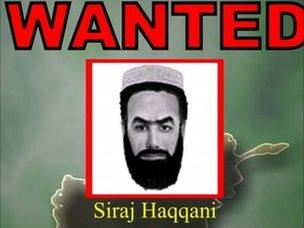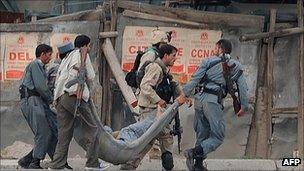Haqqanis: Growth of a militant network
- Published

The Haqqani network has been described as the glue that binds together militant groups
US officials have blamed co-ordinated attacks in Kabul on the Haqqani militant network. The Haqqanis have grown from a CIA-backed anti-Soviet group into one of the most feared anti-Western militant organisations in the region, writes the BBC's M Ilyas Khan in Islamabad.
The so-called Haqqani network of militants has been blamed for several high profile attacks against Western, Indian and government targets in Afghanistan.
It is often described by Pakistani officials as a predominantly Afghan militant group.
But its roots reach deep inside Pakistani territory, and speculation over its links to some powerful quarters within the Pakistani security establishment refuse to die down.
The leader of the group, Jalaluddin Haqqani, is a Jadran tribesman from Afghanistan's Paktia province. He owns properties in the neighbouring North Waziristan tribal region of Pakistan.
North Waziristan was the base from where he organised raids against the former Soviet troops that occupied Afghanistan in 1980s.
American officials admit that Mr Haqqani was a prized asset of the Central Intelligence Agency (CIA) back then.
He was also one of the favourite commanders of Pakistan's Inter Services Intelligence (ISI) that decided which commander should get how much international funds and equipment to fight the Soviets.
Many in the West and Pakistan believe he is still an asset of the ISI, though the Pakistani military denies this.
They say the outreach of the Haqqanis would be far too limited without the material, tactical and logistical support of powerful elements in Pakistan.
But in a recent interview with the BBC, Jalaluddin Haqqani's son and its current leader, Sirajuddin Haqqani, has said there have "never been contacts by intelligence agencies of other countries (including Pakistan) which could be effective for us".
Bombing campaign
A late convert to Taliban, Mr Haqqani was one of their top leaders to undertake a last official visit to Islamabad in late 2001, at about the time as the US started to bomb Afghanistan.
Mr Haqqani disappeared in Islamabad, and resurfaced several months later in the Waziristan region where he is credited with carving out the first base of militant resistance against Western forces in the most recent conflict in Afghanistan.

The Haqqani network has been blamed for a string of audacious attacks in Afghanistan and Pakistan
To this day, militants operating out of this base have inflicted more damage than any other group on Western troops in Afghanistan.
The more lethal of these militants are the Pakistani fighters, called Punjabi Taliban by locals in Waziristan, and the so-called foreign fighters of Arab and central Asian origin.
These fighters constitute the bulk of Haqqani network's fighting force.
The growing strength of Waziristan-based militants is seen as having turned the tide against the Americans in Afghanistan in recent years.
Waziristan is seen as the source of Taliban resistance in Kunar and Ningarhar provinces in the north-east of the country, and in the southern militant strongholds of Zabul, Kandahar and Helmand.
When the Americans started their bombing campaign in Afghanistan in late October 2001, thousands of Arab and Central Asian fighters started to pour into South Waziristan.
Some half-hearted attempts by the Pakistani army to check this influx led to a violent conflict in the Wana region of South Waziristan in 2002, and again in 2004.
More than 700 Pakistani soldiers were killed in those clashes.
Subsequently, Pakistanis backed down and allowed militant groups to establish deeper roots there.
By 2006, several local militant groups had emerged across the whole of South Waziristan and North Waziristan, converting the entire area into a virtual no-go zone for Pakistani officials.
Civilian targets
Based in different geographical locations within the region, these groups had different, sometimes conflicting, aims and agendas.
Some of these groups signed peace deals with the Pakistani army, which still hold.
Others were hostile to it and conducted violent campaigns against government and civilian targets in Pakistani cities and towns.
But all groups were largely under the influence of the Haqqanis, and like them, professed allegiance to Mullah Omar, the Taliban's spiritual leader.
Jalaluddin Haqqani's son, Sirajuddin, was the chief negotiator who united various clans of the Ahmadzai Wazir tribe in Wana region of South Waziristan in 2006.
He is also believed to have been instrumental in persuading Baitullah Mehsud, the anti-Pakistan militant commander based in eastern parts of South Waziristan, to negotiate peace with the Pakistani forces in 2005 and again in 2008.
While these peace deals did not hold, collaboration between the Haqqanis and Mehsud's TTP group continued.
They were both blamed for organising a December 2009 suicide attack in Khost province of Afghanistan in which seven CIA operatives were killed.
There is evidence that some top members of the Haqqani network have also been operating in the Pakistani mainland, away from their sanctuary in the Waziristan region.
Between 2008 and 2011, two brothers of Jalaluddin Haqqani, along with some other leaders of the group, have been trying to negotiate peace between the TTP - now headed by Hakimullah Mehsud - and the Shia Turi tribe of the Kurram tribal region.
At least three rounds of talks have so far been held in Peshawar, the capital of the north-western Khyber Pakhtunkhwa province, and in Islamabad.
This serves as an indication of the extent to which the Haqqanis can influence and shape the militant scene in Pakistan and the freedom with which they can move both within the semi-autonomous tribal areas and the Pakistani and Afghan mainlands.